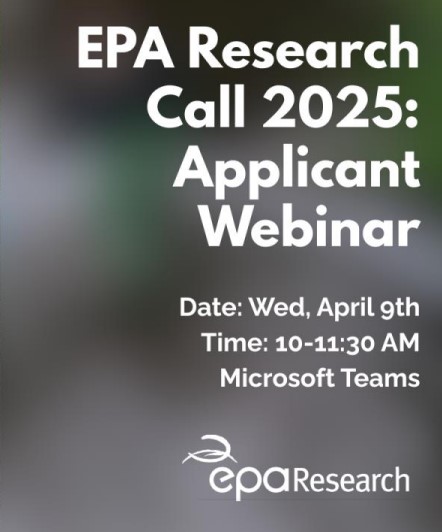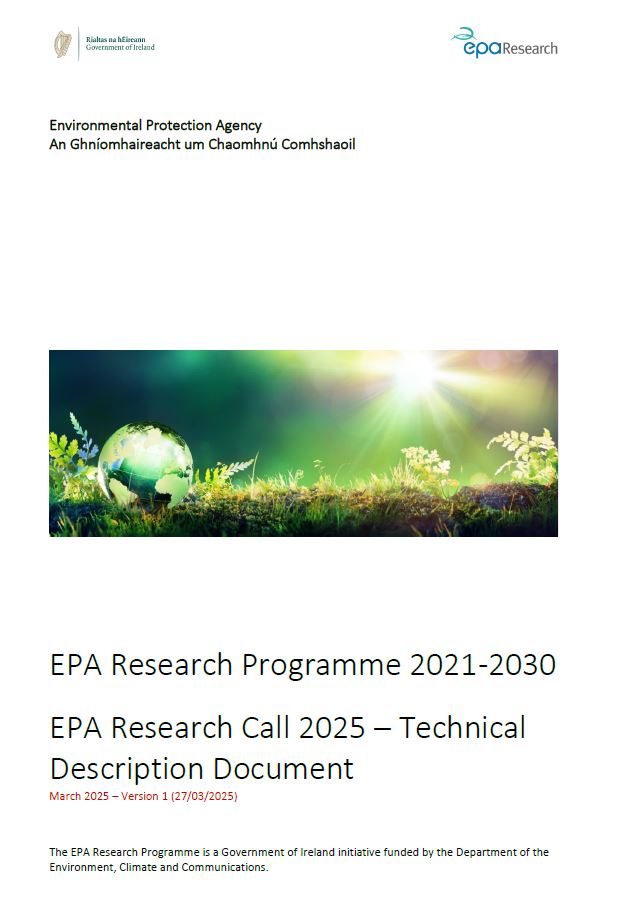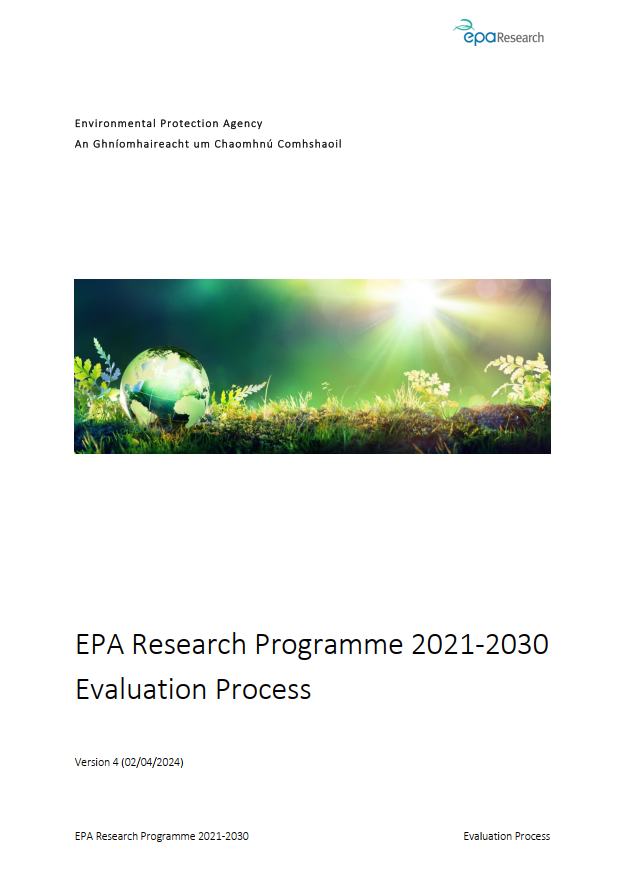Latest Research Publications
EPA Research Report Layout Template
Year: 2025
This template should be used for the preparation of final reports for EPA Research projects.
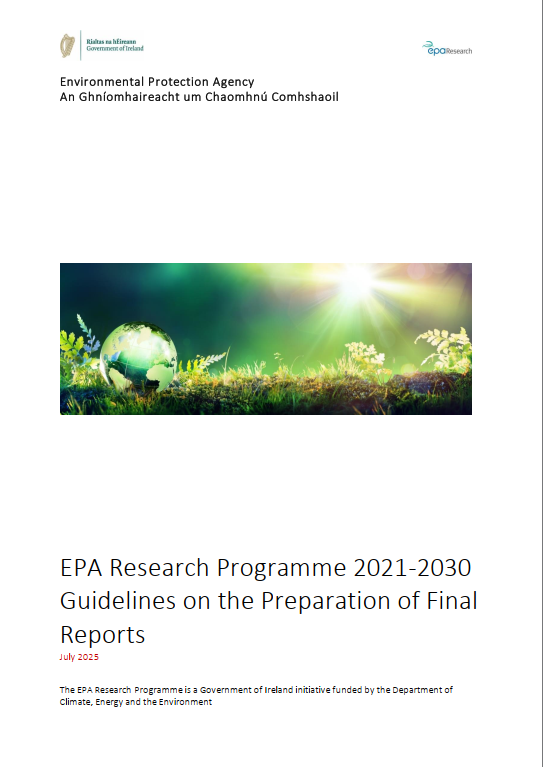
Guidelines on the Preparation of Final Reports
Year: 2025
Guidelines on the Preparation of Final Reports

Research 488: Habitat Mapping, Assessment and Monitoring with High-resolution Unoccupied Aerial Vehicle Imagery (iHabiMap)
Authors: John Connolly, Charmaine Cruz, James R. Martin, Jerome O Connell, Kevin McGuinness and Philip M. Perrin, June 2025
Year: 2025
Ireland has a wide range of important habitats, identified under Annex I of the EU Habitats Directive, needing protection and restoration. Monitoring, reporting, and verifying these habitats is an essential activity under this directive, but this can be time-consuming and resource-intensive, particularly over large remote areas. This research (iHabiMap) has enhanced our ability to do this by integrating ecological and UAV surveys, image analysis, and machine learning to accurately map coastal, grassland, and upland habitats. iHabiMap produced habitat maps with over 90% accuracy, demonstrating the potential of UAV and AI technology in habitat monitoring. The methodology can support regular habitat assessments, is transferable to other habitat types, and can help monitor the degradation and rehabilitation of dune systems, salt marshes, uplands, and grasslands. The agile research methodology was also adapted to map and monitor the invasive species Spartina anglica in saltmarshes.
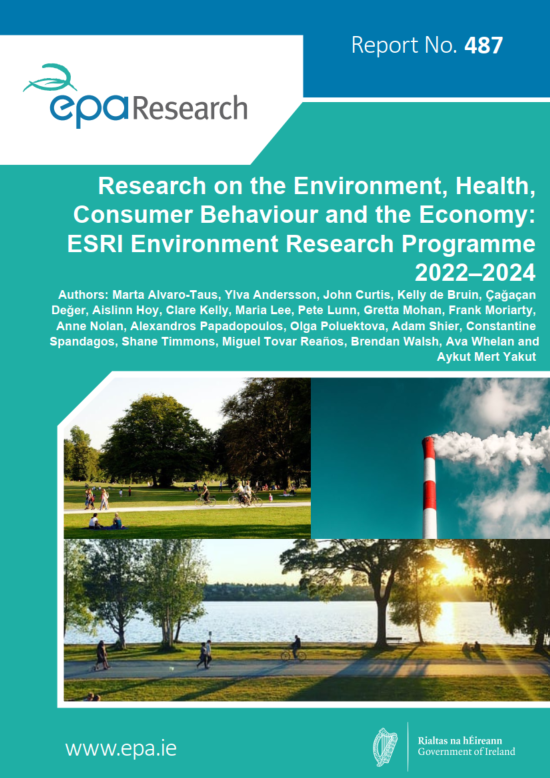
Research 487: Research on the Environment, Health, Consumer Behaviour and the Economy: ESRI Environment Research Programme 2022–2024
Authors: Marta Alvaro-Taus, Ylva Andersson, John Curtis, Kelly de Bruin, Çağaçan Değer, Aislinn Hoy, Clare Kelly, Maria Lee, Pete Lunn, Gretta Mohan, Frank Moriarty, Anne Nolan, Alexandros Papadopoulos, Olga Poluektova, Adam Shier, Constantine Spandagos, Shane Timmons, Miguel Tovar Reaños, Brendan Walsh, Ava Whelan and Aykut Mert Yakut, June 2025
Year: 2025
The EPA/ESRI Environment Research Programme produces policy-relevant applied research at the interface between the environment, economy, and society. This report on this fourth phase provides a summary of 13 studies, produced by the ESRI, that use a range of data and methodological approaches to provide insights into the environmental challenges facing Irish society. The studies include analyses of healthcare costs resulting from poor air quality and water-related diseases, public perceptions and behaviour in relation to environmental risks, the effects of greenwashing and eco-labels on consumers, as well as the role of enforcement in preventing pollution in Ireland.

Evidence Synthesis Report 7: Investigating the Likelihood of a Lough Neagh Bloom Scenario Happening in Ireland
Authors: Philip Taylor, Ezra Kitson, Linda May, Erica Zaja, Alice MacSporran, Zisis Gagkas, Sara Trojahn and Miriam Glendell , June 2025
Year: 2025
This study, conducted by the UK Centre for Ecology & Hydrology and the James Hutton Institute, reviewed the factors that contributed to the harmful algal bloom (HAB) event in Lough Neagh.

Research 486: Proactive Optical Monitoring of Catchment Dissolved Organic Matter for Drinking Water Source Protection (PRODOM)
Authors: John Weatherill, Boris Droz, Elena Fernández-Pascual, Jean O’Dwyer, Emma Goslan, Connie O’Driscoll and Simon Harrison, May 2025
Year: 2025
In Ireland, approximately 82% of public water supplies originate from surface water catchments. This water requires disinfection with chlorine to inactivate pathogens and prevent the spread of waterborne disease. The presence of dissolved organic matter (DOM) in source waters can lead to the formation of potentially carcinogenic disinfection by-products (DBPs), such as trihalomethanes (THM4), of which Ireland has the highest number of reported exceedances in the EU in recent years. This research conducted detailed field and laboratory investigation in the River Lee catchment (Cork, Ireland), supported by predictive modelling using machine learning techniques, to gain more insights in the role of optically active DOM in DBP formation and forecasting. It highlights the value of UV-visible spectroscopy as a cost-effective and non-destructive technology suitable for proactive management of DOM in source water, with a high potential for aiding real-time process control at treatment plants.

Evidence Synthesis Report 6: Just Transition Indicator Framework for Ireland
Authors: J. Andrew Kelly, Ciaran Deegan, Amy Collins, Angela Milimu, Luke Kelleher and Yanika Farrugia, April 2025
Year: 2025
This research was carried out by EnvEcon Decision Support and provides guidance for Government on how to monitor and track success in ensuring a fair, inclusive and equitable transition to a low-carbon economy.

Research 485: Specific Management and Robust Targeting of Riparian Buffer Zones
Authors: Daire Ó hUallacháin, Per-Erik Mellander, Simon Parker, Nikki Baggaley, Mark E. Wilkinson, Allan Lilly and Marc Stutter, April 2025
Year: 2025
With many of Ireland's surface waters classed as less than the minimum of “good ecological status” under the Water Framework Directive, this research project looked to support optimal targeting and management of riparian margins, in agricultural contexts, for effective management of rivers in Ireland. It delivers a riparian measures database summarising alternative measures for Irish conditions, evaluating their effectiveness and wider ecosystem service benefits. Core to the research is the “Right Measure, Right Place” concept, a key tenet of Ireland’s River Basin Management Plan (2022–2027). Tools were developed to identify locations for maximum impact, using landscape context to prioritise 16 identified mitigation measures. The project aims to help policymakers and other research projects expand beyond traditional approaches to achieve water quality objectives under policies like the Common Agricultural Policy and Water Framework Directive.

Research 484: Framework for Characterising Oligotrophic (3110 and 3160) Lakes Using Practical Methods and Assessment Tools
Authors: Heather T. Lally, Martin Gammell, Emma Gray, Giovanni Cappelli and Cilian Roden, April 2025
Year: 2025
Oligotrophic lake habitats, which are characterised by low accumulation of dissolved nutrient salts are protected freshwater habitats in Ireland. These habitats support limited life forms, mainly algae and macroinvertebrates. This research report, from the "Peat Lakes" project, looks at the potential of these organisms to help in characterising and conserving oligotrophic lakes using practical methods and assessment tools. It assesses and provides findings on water chemistry and data from plant communities, including macrophytes, algal communities (including desmids), and invertebrate communities from 24 water bodies within Atlantic blanket bog landscapes in the west of Ireland. The report makes several recommendations and provides relevant stakeholders from state agencies with important information for the conservation of small water bodies (area ≤ 0.01 km²), to support the monitoring of favourable conservation conditions in oligotrophic lake habitats, under the EU Habitats Directive.

Research 483: Just Resilience and Adaptation in Ireland (JustAdapt)
Authors: Stefano Ceolotto, Niall Farrell, Pranav Kakkar and Anita Vollmer, April 2025
Year: 2025
Both the impacts of climate change and the policy responses to mitigate emissions affect different sections of society in different ways. The JustAdapt research project is the first national-level study to consider socioeconomic vulnerability alongside climate change impacts at a local level in Ireland. It includes modelling extreme weather events to identify where climate impacts and socioeconomic vulnerability coincide, assessing local economic impacts of climate policies, and developing guidelines for incorporating nature-based solutions, equity and justice into climate policy decision-making. Overall, the research offers policymakers, planners, and stakeholders’ insights to design fair, effective, and sustainable climate adaptation policies and strategies, while considering socio-economic vulnerabilities and promoting nature-based solutions for a resilient future.

Research 482: Mitigating Agricultural Impacts on Water Quality through Research and Knowledge Exchange
Authors: Mary Ryan, Cathal O’Donoghue, Denis O’Hora, Jenny McSharry, Pat Murphy, Noel Meehan, Karen Daly, Owen Fenton, Yuting Meng, Paula Cullen, Rossella Di Domenico, Thomas Moloney, LoriRae van Laren, Daniel Urban, Niall McLoughlin, Emma Byrne, Catherine Seale and Maura Farrell, March 2025
Year: 2025
This research report explores improving water quality affected by agricultural practices using a multi-disciplinary approach .It incorporated systems analysis of actors and incentives, spatial analysis on the effects of rural activity, analysis of factors impacting measure adoptions, and socio-economic and behavioural psychology studies to identify drivers of pro-environmental activity. Key findings highlight the necessity of localised solutions, the importance of farm advisors and local farming 'champions', collaboration among stakeholders, and providing knowledge and resources to farmers. It also finds that trust between advisors and farmers, upskilling advisors, and understanding the direct and indirect barriers to farm-level behaviour change are seen as crucial for fostering sustainable agricultural practices. The researchers highlights the importance of incentives and behavioural interventions to promote pro-environmental practices.

Evidence Synthesis Report 5: Study of the Increased Risk of Corrosion with the Use of Fatty Acid Methyl Ester (FAME) as a Diesel Additive
Authors: Carmel Breslin, Gillian Collins, Tara Barwa and Daniele Alves, March 2025
Year: 2025
Biofuels, including fatty acid methyl ester (FAME)-based biodiesels, have the potential to reduce greenhouse gas emissions from our transport sector. However, as these FAME-based biodiesels have become more common, challenges related to storage issues have emerged. FAME is not compatible with all materials, and corrosion issues have been reported during longer-term storage. This evidence synthesis research examines the properties of FAME-based biodiesels, the nature of corrosion reactions associated with these biofuels, the potential risk of corrosion and how to mitigate the risk. The report provides guidance on the general protocols to follow when managing and storing FAME-based biodiesels to mitigate corrosion risks.

Research 481: Addressing the Political Economic Barriers to Climate Adaptation in Ireland
Authors: Alice Brawley-Chesworth, Darren Clarke and Danny Marks, March 2025
Year: 2025
Ireland’s climate is experiencing significant changes that impact the economy, society, and environment. Historically, Ireland’s climate policies have prioritised reducing emissions over adapting to unavoidable climate impacts. With climate-related costs projected to reach billions of euros annually by 2050, this research assesses how current governance structures support or hinder adaptation. Using an innovative political economy approach, the research sought to uncover the interests, incentives, and institutional factors that shape adaptation decisions in the key sectors of agriculture, flood risk management, and water services. The research indicates that political, economic, and social factors hinder Ireland's climate adaptation progress. Barriers include a perceived lack of urgency and the competition between adaptation and immediate short-term priorities. This report provides a roadmap for policymakers, sector leaders, and communities to strengthen adaptation efforts.

Research 480: PestMan: Pesticide Management for Better Water Quality
Authors: Mark G. Healy, Alma Siggins, Paraic C. Ryan, John McGinley, Jennifer Harmon O’Driscoll, Shane Scannell, Per Erik Mellander and Liam Morrison, March 2025
Year: 2025
With world populations increasing the use of pesticides has also increased to bolster crop yields and cater for global food demand. Pesticides released unintentionally from both the agricultural and urban sectors have the potential to enter non-target ecosystems and pose a threat to the environment and human health. The PestMan research project used a multidisciplinary approach, integrating soil processes, molecular biology, engineering, and quantitative risk assessment methodologies to address the environmental and human health impacts of pesticides. It sets out to understand the drivers and pressures of pesticide use, study their fate and persistence, evaluate their risks, and develop a cost-effective, passive remediation method to mitigate these issues. The research developed a multidisciplinary framework to understand and mitigate the environmental and human health impacts of pesticides, focusing on their movement, persistence, risks, and effective remediation strategies

Research 479: A Review of Circular Economy and Bioeconomy Governance in Ireland
Authors: Joanna O’Riordan, Richard Boyle, Seán Keating and Fergal O’Leary, March 2025
Year: 2025
The circular economy and bioeconomy are critical elements of tackling climate change and other global challenges like waste, and pollution, biodiversity loss and water stress, with the aim of using finite resources more sustainably. This research details the complexities and challenges of governance and policy implementation for the circular economy and bioeconomy in Ireland and highlights the need for robust structures, clear roles, leadership, and stakeholder engagement. It concludes that there is an opportunity in the forthcoming Whole-of-Government Circular Economy Strategy and Bioeconomy Strategy to promote meaningful policy coherence and greater collaboration to leverage impactful actions learning and synergies in the implementation of both policy areas.

Research 471: Updated High-resolution Climate Projections for Ireland
Authors: Paul Nolan, March 2025
Year: 2025
Climate change poses significant risks to Ireland’s economy, society and environment. To enable appropriate mitigation and adaptation measure into the future, it is imperative that planners and policymakers are informed about future climate change projections. Addressing knowledge gaps in regional climate projections, this research used scenario-based projections (SSP1-2.6, SSP2-4.5, SSP3-7.0 and SSP5-8.5) to simulate the future climate in Ireland (up to the year 2100). It used the most up-to-date regional climate models at a higher resolution (4 km grid spacing). Broadly in agreement with previous research, this research projects increases in temperature and heatwaves, decreases in frost and snow, increases in both dry and heavy rainfall events, less wind and longer growing seasons among many other things. The research provides Ireland with data to explore its future climate and enables an assessment of impacts across sectors, at regional and local levels.

Research 478: Critical Raw Materials for Ireland for a Resource-Efficient Circular Economy (CIRCLE)
Authors: Ahmar Murtaza, Maham Mahnoor, Anum Inam, Ali Akbar Shah, Muhannad Ahmed Obeidi and Inam Ul Ahad, February 2025
Year: 2025
Global raw material supply is becoming increasingly complex and uncertain, exacerbated by resource scarcity and supply chain vulnerabilities. Critical raw materials (CRM) are vital for industrial growth and competitiveness and a resilient circular economy. Ireland lacked a raw material criticality assessment methodology tailored to its unique economic and resource landscape. To address this gap, the CIRCLE research project developed a CRM methodology tailored to Ireland’s economic and resource landscape. Three methods were developed for assessing raw material criticality with a total of 42 raw materials assessed. The research finding assist stakeholders, including industry and policymakers, in identifying essential materials for various industrial sectors, providing insights into potential supply risks and economic impacts. The report recommends the establishment of a national database to include CRM, Circular material use rate (CMUR) and material flow analysis data.
